Portulaca vygie, Purslane, Moss Rose - Portulaca grandiflora
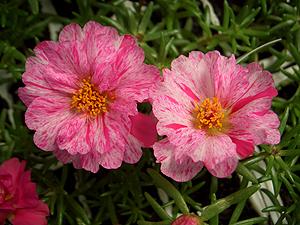 Portulaca 'Pink Stripe'This family of plants consists of mainly succulent herbs and has about 40 species, of which eight occur in southern Africa. They are also native to Brazil, Argentina, Uruguay, and throughout the warmer parts of the world. Portulaca grandiflora are native to Brazil and one of a very few annual succulents that are popular summer annuals around the world, because they don't require a lot of water and have no real pest problems; working really well in a xeriscape (dry) garden setting. Their masses of double; brilliant jewel-toned blooms are available in shades of rose, pink, red, purple, lavender, yellow, orange and white, and are often striped or spotted with contrasting colours.
Portulaca 'Pink Stripe'This family of plants consists of mainly succulent herbs and has about 40 species, of which eight occur in southern Africa. They are also native to Brazil, Argentina, Uruguay, and throughout the warmer parts of the world. Portulaca grandiflora are native to Brazil and one of a very few annual succulents that are popular summer annuals around the world, because they don't require a lot of water and have no real pest problems; working really well in a xeriscape (dry) garden setting. Their masses of double; brilliant jewel-toned blooms are available in shades of rose, pink, red, purple, lavender, yellow, orange and white, and are often striped or spotted with contrasting colours.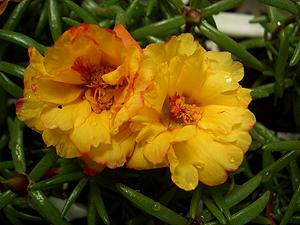 Portulaca 'Yellow'These prostrate, spreading plants have an upright, mounding habit, making them a perfect rockery or pebble garden plant and an ideal groundcover or border plant for hot flower beds. Their trailing habit makes them great performers in hanging basket or mixed containers. Allow them to spill over pots for months of hassle free colour.
Portulaca 'Yellow'These prostrate, spreading plants have an upright, mounding habit, making them a perfect rockery or pebble garden plant and an ideal groundcover or border plant for hot flower beds. Their trailing habit makes them great performers in hanging basket or mixed containers. Allow them to spill over pots for months of hassle free colour.
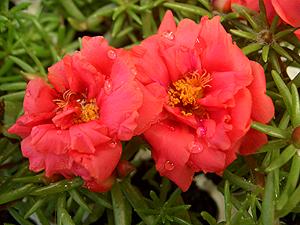 Portulaca 'Red'Portulaca grows well throughout South Africa, especially in the winter rainfall regions but does not do well in very high summer rainfall regions. Plant them into the garden when all danger of frost is over. They must be planted in full sun because the flowers only open in the sun and will close at night and on cloudy days. They grow well in poor, sandy or gravelly soils but will grow in any soil as long as it drains well. Although they are drought hardy, they will respond well to moderate but regular watering during hot, dry spells. The seedlings will grow quickly to about 10 to 15cm tall and 30cm wide and require no deadheading.
Portulaca 'Red'Portulaca grows well throughout South Africa, especially in the winter rainfall regions but does not do well in very high summer rainfall regions. Plant them into the garden when all danger of frost is over. They must be planted in full sun because the flowers only open in the sun and will close at night and on cloudy days. They grow well in poor, sandy or gravelly soils but will grow in any soil as long as it drains well. Although they are drought hardy, they will respond well to moderate but regular watering during hot, dry spells. The seedlings will grow quickly to about 10 to 15cm tall and 30cm wide and require no deadheading.
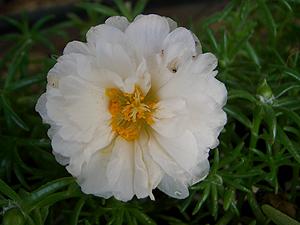 Portulaca 'White'The seeds are as tiny as dust, so mix them with sand before sowing to make them easier to scatter. Seeds can be sown in seedling trays or directly into well-prepared garden beds in spring and summer. They germinate best in warm soil temperatures between 24 and 26°C. The seeds need light to germinate so do not cover them. Germination takes 2 to 4 days in ideal temperatures but will take longer in cooler soil. The plants will flower about 12 to 14 weeks after sowing. Place the seedling trays in a bright, warm place as Portulaca is very sensitive to cool temperatures and low- light levels. In warm climates it may self-seed itself in the garden.
Portulaca 'White'The seeds are as tiny as dust, so mix them with sand before sowing to make them easier to scatter. Seeds can be sown in seedling trays or directly into well-prepared garden beds in spring and summer. They germinate best in warm soil temperatures between 24 and 26°C. The seeds need light to germinate so do not cover them. Germination takes 2 to 4 days in ideal temperatures but will take longer in cooler soil. The plants will flower about 12 to 14 weeks after sowing. Place the seedling trays in a bright, warm place as Portulaca is very sensitive to cool temperatures and low- light levels. In warm climates it may self-seed itself in the garden.
Bedding Begonia, Wax-leaf Begonia - Begonia semperflorens
 Begonia 'Baby Wings' Pink. Picture courtesy Ball StraathofCondensed Version:
Begonia 'Baby Wings' Pink. Picture courtesy Ball StraathofCondensed Version:
Begonias are available as small compact plants which are perfect for flower borders, and the taller growing types are great in the middle of the flower border. The large upright or trailing types are stunning in containers and hanging baskets, as well as in garden beds.
Begonia ‘Rex’ and Begonia 'Gryphon' are grown for their colourful tropical-looking leaves, which often have amazing patterns, and Begonia x tuberhybrida are grown for their beautiful flowers. These begonias are popular house plants but in warm, frost-free areas they thrive in garden beds and in pots on secluded patios.
Garden begonias are available in various shapes and sizes, and the flowers come in many beautiful single or bi-coloured shades of pink, white, red, orange, and yellow. They will flower all season long, until the first frosts, and in warm climates they can bloom all year round, and their attractive waxy leaves, which can be green or bronze, are an added bonus.
In frost-free and subtropical climates many types of begonias can go on and on for years and are grown as evergreen bi-annual or perennial plants, which are pruned down when they have finished blooming to encourage bushiness and re-blooming. In cold climates which experience frost in winter begonias are treated as summer annuals, but the bigger growing types can be overwintered in large pots, or in sheltered parts of the garden.
Although begonias will grow in quite a lot of shade they flower best in positions where they receive dappled or bright shade, in deep shade they become leggy and less floriferous. Varieties with green leaves will tolerate more shade than those with bronze leaves.
Plant them in rich, well-drained soil, and water regularly, but don’t over water. Try not to wet the leaves if they get morning sun as this can burn them. Begonias are heavy feeders and for those growing in garden beds a regular fertilising every 4 to 6 weeks with water soluble fertilisers for flowering plants, mixed at half the recommended strength, will keep them blooming beautifully. Potted plants will need more frequent feeding, either monthly or fortnightly. Frequent pinching back of the plants results in fuller plants and also encourages more blooms.
Although they look at their best when watered regularly, once established, begonias can tolerate mild drought conditions due to the reserves in their thick, fleshy stems and leaves. In the very hot summer months it is important to mulch around the plants as this helps to keep the roots cool and significantly reduces evaporation.
Space the plants correctly to allow good air flow between them as this will reduce the chance of any diseases taking hold of the plant.
 Begonia 'Big' Bronze Leaf Rose. Picture courtesy Ball StraathofFull Version:
Begonia 'Big' Bronze Leaf Rose. Picture courtesy Ball StraathofFull Version:
Description, History & Interesting Facts:
Begonias are truly the backbone of the flower garden and are very free-flowering. They are available as small compact plants which are perfect for flower borders, and the taller growing types are great in the middle of the flower border. The large upright or trailing types are stunning in containers and hanging baskets, as well as in garden beds.
Begonia ‘Rex’ and Begonia 'Gryphon' are grown for their colourful tropical-looking leaves, which often have amazing patterns, and Begonia x tuberhybrida are grown for their beautiful flowers. These begonias are popular house plants but in warm, frost-free areas they thrive in garden beds and in pots on secluded patios.
Garden begonias are available in various shapes and sizes, and the flowers come in many beautiful single or bi-coloured shades of pink, white, red, orange, and yellow. They will flower all season long, until the first frosts, and in warm climates they can bloom all year round, and their attractive waxy leaves, which can be green or bronze, are an added bonus.
Begonias belong to the Begoniaceae family and there are over 1,500 known species of annuals, perennials, shrubs and climbers. They are native to the moist, tropical and subtropical regions of all the continents, except for Australia
Bedding Begonia, Wax Begonia (Begonia semperflorens)
 Begonia 'Bossa Nova' Formula Mix. Picture courtesy Ball StraathofThese popular, compact plants grow +-20 to 25cm tall and have beautiful green or bronze foliage. The flowers vary in size, depending on the variety, and can be white or various shades of pink and red, and many are available with bicoloured flowers. The Latin name “semperflorens” means ever-flowering, as they bloom from late spring to the first frosts, and in frost-free regions they can bloom almost all year. In cold, frosty gardens they are planted as summer annuals.
Begonia 'Bossa Nova' Formula Mix. Picture courtesy Ball StraathofThese popular, compact plants grow +-20 to 25cm tall and have beautiful green or bronze foliage. The flowers vary in size, depending on the variety, and can be white or various shades of pink and red, and many are available with bicoloured flowers. The Latin name “semperflorens” means ever-flowering, as they bloom from late spring to the first frosts, and in frost-free regions they can bloom almost all year. In cold, frosty gardens they are planted as summer annuals.
They vary in size, and the very compact dwarf types can be used as an edging for flower beds and do well in pots and hanging baskets. The larger varieties can grow +-30 to 40cm tall and can be used to fill in the middle section a flower bed, and if planted in large groups they create a wonderful, long lasting show of colour.
Begonia ‘Baby Wings’
These little upright mounded plants are summer annuals which grow +-38cm tall and 30cm wide. They are available in various shades of pink, red and white and the foliage can be green or bronze. Because they are extremely heat tolerant and stand up well in stressful conditions, they are ideal for both garden beds and containers.
 Begonia 'Dragon Wings' Pink. Picture courtesy Ball StraathofBegonia ‘Planet’
Begonia 'Dragon Wings' Pink. Picture courtesy Ball StraathofBegonia ‘Planet’
This selection of summer annuals has a mixture of bronze and green-leaved varieties, and these little upright, mounded plants grow +-38cm tall and 30cm wide. They are available in various shades of pink, red and white, and because they are extremely heat tolerant and stand up well in stressful conditions, they are ideal for both garden beds and containers.
Begonia RL ‘Eris’
These annual begonias have bronze leaves and are perfect partners to the green-leaved Ceres begonias, putting on a season-long show of colour. The little upright, mounded plants grow +-25cm tall and 20cm wide, and are available in various shades of pink, red, and white.
Begonia GL 'Ceres’
This annual begonia has green leaves and is smothered in blooms all season long. It is a perfect partner for the bronze-leaved Eris begonias. It is specifically selected for South African conditions and grows +-25cm tall and 20cm wide.
Begonia ‘Sprint Plus’
This annual begonia has green leaves and flowers profusely all summer long. It is the most uniform Begonia semperflorens series on the market and is available in gorgeous single colours and bi-colours, in shades of pink, red, orange and white.
 Begonia GL 'Ceres' Pink. Picture courtesy Ball StraathofBegonia ‘Big’
Begonia GL 'Ceres' Pink. Picture courtesy Ball StraathofBegonia ‘Big’
This summer annual is a stunning landscape begonia which boasts both bronze and green-leaf varieties for a colourful show, and its large 5 to 7cm flowers are held above the glossy leaves on upright arching plants, +-60cm tall and 38cm wide. The large flowers come in shades of pink and red, making a bold statement in the garden when planted in large drifts, and are stunning in large containers and hanging baskets.
Begonia ‘Megawatt’
This bi-annual with its lush foliage and pink or red flowers grows +-71cm tall and is available in green or bronze-leaved varieties. It performs well in the heat and flowers non-stop throughout summer, making it perfect for garden beds, containers and hanging baskets.
Begonia ‘Dragon Wings’
This bi-annual begonia is a classic garden favourite with its green leaves and gorgeous red or pink flowers, and it delivers excellent garden performance across a wide range of conditions. It grows to a height of +-38cm with a spread of 45cm, and its beautifully arching, pendulous habit makes it perfect for hanging baskets and containers, as well as garden beds.
 Begonia 'Megawatt' Red Bronze Leaf. Picture courtesy Ball StraathofBegonia ‘Bossa Nova’
Begonia 'Megawatt' Red Bronze Leaf. Picture courtesy Ball StraathofBegonia ‘Bossa Nova’
Bring the bright colours of carnival to your containers with Bossa Nova. It is available in both bronze and green-leaved varieties and is very free-flowering with a bright range of colours like orange, red, rose pink, yellow, and white. This well branched cascading annual grows +-40cm tall 50cm wide and looks amazing in a large container or hanging basket, either singly or as part of a combo.
Rhizomatous begonias like Begonia ‘Rex’ and Begonia 'Gryphon' are grown for their colourful tropical-looking leaves, which often have amazing patterns, and Begonia x tuberhybrida is grown for its beautiful flowers. These begonias are popular house plants but can be grown outdoors in frost-free regions in a secluded, shady garden bed, or in pots on a patio.
Members can click here to read more about Begonia Rex.
Members can click here to read more about Begonia 'Gryphon'
Members can click here to read more about Begonia x tuberhybrida
Cultivation/Propagation:
In frost-free and subtropical climates many types of begonias can go on and on for years and are grown as evergreen bi-annual or perennial plants, which are pruned down when they have finished blooming to encourage bushiness and re-blooming. In cold climates which experience frost in winter begonias are treated as summer annuals, but the bigger growing types can be overwintered in large pots, or in sheltered parts of the garden.
 Begonia 'Planet' Mix. Picture courtesy Ball StraathofAlthough begonias will grow in quite a lot of shade they flower best in positions where they receive dappled or bright shade, in deep shade they become leggy and less floriferous. Varieties with green leaves will tolerate more shade than those with bronze leaves
Begonia 'Planet' Mix. Picture courtesy Ball StraathofAlthough begonias will grow in quite a lot of shade they flower best in positions where they receive dappled or bright shade, in deep shade they become leggy and less floriferous. Varieties with green leaves will tolerate more shade than those with bronze leaves
Plant them in rich, well-drained soil, and water regularly, but don’t over water. Try not to wet the leaves if they get morning sun as this can burn them. Begonias are heavy feeders and for those growing in garden beds a regular fertilising every 4 to 6 weeks with water soluble fertilisers for flowering plants, mixed at half the recommended strength, will keep them blooming beautifully. Potted plants will need more frequent feeding, either monthly or fortnightly. Frequent pinching back of the plants results in fuller plants and also encourages more blooms.
Although they look at their best when watered regularly, once established, begonias can tolerate mild drought conditions due to the reserves in their thick, fleshy stems and leaves. In the very hot summer months it is important to mulch around the plants as this helps to keep the roots cool and significantly reduces evaporation.
 Begonia Rl 'Eris' Mix. Picture courtesy Ball StraathofSpace the plants correctly to allow good air flow between them as this will reduce the chance of any diseases taking hold of the plant.
Begonia Rl 'Eris' Mix. Picture courtesy Ball StraathofSpace the plants correctly to allow good air flow between them as this will reduce the chance of any diseases taking hold of the plant.
Many types like the bedding varieties can be grown from seed but the easiest way to propagate begonias is from cuttings, making them great plants for gardeners on a budget. Seed can be sown into seedling trays and germinates well in soil temperatures between 23 to 26°C. The seeds are extremely small and need light to germinate so do not cover them with soil. Germination will take 14 to 21 days and the plants will start blooming about 14 to 18 weeks after sowing. The rhizomatous species are easy to propagate by division of the rhizomes and from stem or leaf cuttings.
Pests & Diseases:
No serious insect or disease problems affect begonias, but watch out for caterpillars, mealybugs and thrips.
Begonias can be susceptible to fungal diseases like bacterial leaf spot, powdery mildew, blight and stem and crown rots. Fungal diseases are prevalent when conditions are too wet or too humid to allow for appropriate drying out of the leaves. To help prevent fungal diseases, water early in 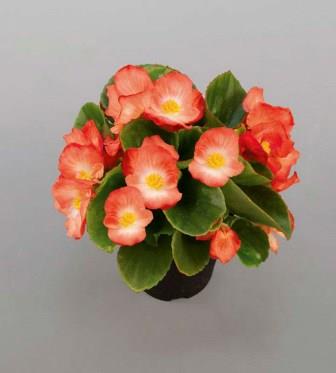 Begonia 'Sprint Plus' Orange Bicolour. Picture courtesy Ball Straathofthe morning to allow the leaves to dry out before nightfall, and ensure that the plants are correctly spaced and have good air flow around the leaves.
Begonia 'Sprint Plus' Orange Bicolour. Picture courtesy Ball Straathofthe morning to allow the leaves to dry out before nightfall, and ensure that the plants are correctly spaced and have good air flow around the leaves.
Warning:
There are more than 500 kinds of begonias, all of which are considered non-poisonous, and begonias are commonly listed as acceptable indoor and outdoor plants which are safe to have around children and pets.
Impatiens, Busy Lizzy, Touch-me-not, New Guinea Impatiens, Sunpatiens - Impatiens
 Impatiens Double Fiesta 'Bonita White' Picture courtesy www.ballstraathof.co.zaCondensed Version:
Impatiens Double Fiesta 'Bonita White' Picture courtesy www.ballstraathof.co.zaCondensed Version:
Gardeners have always loved Impatiens for shady gardens for their ease of growth and beautiful array of colours, but today gardeners are spoilt for choice when it comes to Impatiens, and breeders continue to surprise us with brilliant new garden hybrids. Some can even be grown in full sun and take heat and humidity.
The old-fashioned shade-loving Impatiens, (Impatiens walleriana) will flower all summer long, and available in colours from white through every shade of pink and magenta to oranges and reds; as well as those with starry centres and swirls, and lovely selections of double-flowered varieties. Most modern varieties are dwarf and compact; growing 15 to 30cm tall and 10 to 15cm wide. These are perfect border and in pots, hanging baskets, window boxes, in massed beds and underneath trees, for a dazzling display.
Because New Guinea Impatiens can take a lot more sun than the ordinary impatiens they are even more versatile in the garden. Their flowers are also a lot larger than ordinary impatiens and come in a vast colour range, covering every shade of red, orange, pink, lavender and white. They are also a lot taller, growing from 30 to 70cm in height. Many varieties also have interestingly coloured foliage in tones of green, together with plum and bronze, or golden to clear yellow. Their bright leaves and big, showy flowers will liven up any spot in the garden, and they are stunning in hanging baskets, window boxes and containers of all kinds.
Sunpatiens are grown the same as New Guinea Impatiens but thrive in full sun and hot, humid weather, as well as in semi-shade. They come in an excellent colour range, making them excellent container and bedding plants for long lasting colour. Sunpatiens also come in three sizes: compact, spreading, and vigorous. Both the compact and spreading plants are perfect for containers. The compact ones can fill in gaps when combined with other annuals; while a single spreading one will fill out a hanging basket or pot spectacularly, or grow quickly and flower abundantly in garden beds.
Caring is easy, as long as you keep the plants well-watered throughout the hottest parts of the year. They are all tender to frost, and in cold regions are grown as summer annuals which are planted out in spring after all danger of frost is over. In warmer regions they can be grown year round, and they will perform as short-lived perennials.
The most important tip is to ensure that the soil has perfect drainage, so plant in a light, moist, well-drained soil, and for impatiens planted in containers, use a good quality commercial potting soil that contains peat moss and either perlite or vermiculite.
It is also vital to allow for plenty of air circulation around the plants, as this helps prevent fungal infections. Overcrowding can be fatal, so space your plants correctly.
Even though the plants love regular watering, the soil must not remain soggy, and to help prevent diseases it is better to avoid overhead watering, and to water early in the day to ensure that the plants are totally dry by nightfall.
Use fertiliser sparingly, as too much fertiliser weakens plants and makes them more susceptible to disease. Feeding is not really necessary for plants in garden beds, but potted specimens can be fed about every 6 to 8 weeks, using a liquid fertiliser for flowering plants, at half the recommended strength.
 Impatiens 'Sunpatiens' Picture courtesy www.nuleaf.co.zaFull Version:
Impatiens 'Sunpatiens' Picture courtesy www.nuleaf.co.zaFull Version:
Description, History & Interesting Facts:
Gardeners have always loved Impatiens for shady gardens for their ease of growth and beautiful array of colours, but today gardeners are spoilt for choice when it comes to Impatiens, and breeders continue to surprise us with brilliant new garden hybrids. Some can even be grown in full sun and take heat and humidity, much to the delight of gardeners around South Africa. These exciting varieties ensure that Impatiens remains one of our most popular summer bedding plants.
We have always relied on the commonly called “Busy Lizzy” or “Touch-me-not” (Impatiens wallerana) for their ease of growth in difficult shady areas, as well as for their wide range of colours. Then the irresistible (Impatiens hawkeri,) commonly called “New Guinea Impatiens” hit the shelves, and caused quite a stir! These were taller growing Impatiens with larger flowers in vibrant colours, and often with colourfully variegated leaves, and because they could take a lot more sun than ordinary Impatiens, became an instant hit. Today we are also blessed with a relatively new hybrid called “Sunpatiens” (Impatiens hawkeri hybrid) which grows in full sun or semi-shade, and even thrives in hot, humid weather, greatly expanding the area in which Impatiens can be grown in South Africa.
Impatiens is a large family of plants which is widely distributed in the subtropics and tropics of Asia and Africa, where they never stop flowering. New Guinea Impatiens is native to New Guinea, and all our modern hybrids are bred from species collected there and later in Java and the Sulawesi Islands. Sunpatiens is a hybrid bred by the Japanese seed company Sakata. It is a careful combination of wild “traditional” impatiens (from a plant species native to Indonesia) with the larger, heat-loving Impatiens hawkeri, native to New Guinea.
 Impatiens Super Elfin 'Paradise Mix' Picture courtesy www.ballstraathof.co.zaIn the Garden:
Impatiens Super Elfin 'Paradise Mix' Picture courtesy www.ballstraathof.co.zaIn the Garden:
Impatiens really give you bang for your money and are quite reliable in the garden as long as they can be watered regularly, so group them together with other water-loving plants. Water is becoming a real luxury in South Africa, and more and more expensive, so be realistic when planning your flower garden by grouping plants together according to their watering requirements. Use smaller areas of the garden for those plants you simply love but which will require regular watering. Grouping them together will not only make watering your garden much easier, but it’s also just common sense.
The old-fashioned shade-loving Impatiens, (Impatiens walleriana) will flower all summer long, and thousands of varieties are available, with colours ranging from white through every shade of pink and magenta to oranges and reds; as well as those with starry centres and swirls. Lovely selections of double-flowered varieties that look just like miniature roses are especially beautiful in containers. They vary in height but most of the modern varieties are dwarf and compact; growing 15 to 30cm tall and 10 to 15cm wide. These are perfect border and container plants, so plant them everywhere in the shade; in pots, hanging baskets, window boxes, in massed beds and underneath trees, for a dazzling display all summer long. The fully blown seedpods suddenly pop open at even the lightest touch, spreading the seeds far and wide, hence their common name “touch-me-not.” This fascinates children and they will run around popping the seeds with glee.
Because New Guinea Impatiens can take a lot more sun than the ordinary impatiens they are even more versatile in the garden. Their flowers are also a lot larger than ordinary impatiens and come in a vast colour range, covering every shade of red, orange, pink, lavender and white. They are also a lot taller than ordinary impatiens, growing from 30 to 70cm in height. Many varieties also have interestingly coloured foliage in tones of green, together with plum and bronze, or golden to clear yellow. Their bright leaves and big, showy flowers will liven up any spot in the garden, and they are stunning in hanging baskets, window boxes and containers of all kinds, requiring little maintenance, and no deadheading.
Sunpatiens come in an excellent colour range and thrive in full sun and hot, humid weather, but can also be grown in semi-shade, making them excellent container and bedding plants for long lasting colour. Sunpatiens also come in three sizes: compact, spreading, and vigorous. Both the compact and spreading plants are perfect for containers. The compact ones can fill in gaps when combined with other annuals; while a single spreading one will fill out a hanging basket or pot spectacularly, or grow quickly and flower abundantly in garden beds.
 Impatiens 'Sunpatiens' Picture courtesy www.tuberflora.co.zaCultivation/Propagation:
Impatiens 'Sunpatiens' Picture courtesy www.tuberflora.co.zaCultivation/Propagation:
Caring for Impatiens is easy, as long as you keep the plants well-watered throughout the hottest parts of the year. They are all tender to frost, and in cold regions are grown as summer annuals which are planted out in spring after all danger of frost is over. In warmer regions they can be grown year round, and they will perform as short-lived perennials.
The most important tip to growing healthy Impatience is to ensure that the soil has perfect drainage, so plant them in a light, moist, well-drained soil, and for impatiens planted in containers, use a good quality commercial potting soil that contains peat moss and either perlite or vermiculite.
It is also vital to allow for plenty of air circulation around the plants, as this helps prevent fungal infections. Overcrowding can be fatal, so space your plants correctly.
Even though the plants love regular watering, the soil must not remain soggy, and to help prevent diseases it is better to avoid overhead watering, and to water early in the day to ensure that the plants are totally dry by nightfall.
Use fertiliser sparingly, as too much fertiliser weakens plants and makes them more susceptible to disease. Feeding is not really necessary for plants in garden beds, but potted specimens can be fed about every 6 to 8 weeks, using a liquid fertiliser for flowering plants, at half the recommended strength.
Impatiens, Busy Lizzy, Touch-me-not plant (Impatiens walleriana) is not suited to very dry or humid regions and thrives in semi-shade to light sunshine. In hotter regions, protect them from the fierce midday sun and excessive winds, which will cause the flowers and leaves to scorch.
New Guinea Impatiens (Impatiens hawkeri) will grow and bloom for a very long time in warm regions and can be planted out at any time, but if you live in cold and frosty regions don't rush to plant New Guinea impatiens out too early in spring, as the plants prefer consistent daytime temperatures between 22 and 29°C. New Guinea Impatiens love to receive full morning sun or bright shade throughout the day, and really don't like total shade. In very hot regions, protect them from the fierce midday sun and excessive winds, which will cause the flowers and leaves to scorch.
Sunpatiens are a revolutionary new hybrid impatiens which is grown and propagated in the same way as New Guinea Impatiens. It can take full sun or semi-shade, and thrives in heat and humidity. The thicker petals and tough foliage are less prone to disease, and their strong sturdy stems tolerate adverse weather conditions. There is no need to pinch off old flowers as they fall of cleanly.
Propagation:
Impatiens walleriana seed needs quite high soil temperatures to germinate and can be sown indoors in late winter and spring in a germination tray at temperatures between 22 and 25°C. If you do not have a germination tray sow seeds in late spring or early summer. Do not cover the seeds with soil as they require good light to germinate. Cover the seed trays with plastic or glass to maintain 100% humidity and place them in good light but out of direct sunlight. Remove the glass or plastic when the seeds have germinated. Seeds will take from 7 to 14 days to germinate and will start blooming about 10 to 12 weeks after sowing.
New Guinea Impatiens (Impatiens hawkeri) and Sunpatiens seed is harder to obtain but if you do find some, germinate it in seedling trays at soil temperatures between 22 and 28°C - the perfect temperature being 25°C. Impatiens need very good light to germinate so do not cover the seeds with soil, and place the trays in bright light with no direct sunlight. Germination will take 7 to 14 days and the plants will bloom in about 12 to 16 weeks. Plants are also propagated by cuttings taken in spring or summer but most cultivars are patented, and taking cuttings for resale, unless you are a licensed propagator, is illegal.
![]() Problems, Pests & Diseases:
Problems, Pests & Diseases:
Although relatively trouble-free, Impatiens can be affected by some disease and pest problems. However, many of these can usually be avoided through good cultural practices.
Fungal diseases that affect impatiens include root, crown and stem rots, powdery mildew, grey mould and downy mildew. Many growers do not recommend the use of fungicides to treat blights and mildews on impatiens because the fungal spores appear on leaves and petals, and chemicals can damage these delicate plants. Rather, they recommend proper growth and sanitation methods which prevent fungal pathogens from attacking your impatiens in the first place.
Bacterial soft rots are caused by a number of organisms. Affected plants turn brown and mushy near the soil. Seedlings collapse and plants grow slowly. Bacterial leaf spots start as small, water-soaked areas that may encompass the entire leaf.
Root rot and crown disease generally affects impatiens planted in poorly drained soil or pots without sufficient drainage. Dull foliage, wilting and yellowing are the first aboveground symptoms of root and crown disease. Seedlings don't emerge and rot in the soil, and in established plants the stems turn soft and dark, and stunting and death quickly follows. Discard all the plants carefully in garbage bags to prevent the disease spreading, and start afresh. Do not, however, plant again in the same spot for a couple of seasons, since this disease remains in the soil. Good soil drainage and air circulation goes a long way to preventing these diseases.
Botrytis blight, also known as “grey mould” is a fungal disease caused by several species in the genus Botrytis. It affects the buds, flowers, leaves, and bulbs of many plants including: impatiens, African violet, begonia, chrysanthemum, cyclamen, dahlia, geranium, lily, peony, rose, and tulip. The extent and severity depends on weather conditions and cultural practices. This disease is the primary cause of decay in cut flowers, causing the buds and flowers to develop abnormally and turn brown. Flowers may have irregular flecks and brown spots and older flowers tend to rot quickly. The disease often occurs when the weather is warm and humid, but the nights are still a bit chilly. Soft, brown spots appear on the leaves, stems and affected parts may be covered with a grey mould. To help prevent this, don't plant Impatiens, and especially New Guinea Impatiens out too early in spring.
Botrytis fungi overwinter as sclerotia on dead plant debris in the garden, and in the spring, spores form and spread by wind or splashing water to infect dying, wounded, or extremely soft plant tissues. Fungal mycelial strands (web blight) from previously infected plant parts can grow onto healthy plant parts and infect them. The fungus is capable of invading tissue during all periods of the growing season and multiplies rapidly in declining foliage, hence, the need for good sanitation.
To help prevent infection, allow for good air circulation around the plants, do not overfeed, and especially with fertilisers high in nitrogen, water early so the plants have enough time to dry off completely, and avoid overhead watering. If weather conditions are ideal for the appearance of this disease, preventative spraying is best. Otherwise, start spraying immediately with a suitable fungicide like copper sulphate once the infection is noticed, repeating as directed on the product.
Powdery mildew is a common garden disease which is easy to spot, displaying as a powdery white or grey coating on the leaves. Eventually, affected plants develop distorted or stunted growth and the leaves drop. To help prevent this ensure that the plants receive sufficient sunshine, and that they are correctly spaced. Try to water in mid-morning so the leaves have ample time to dry before evening falls. Keep the area around the plant free of leaves and other debris, and immediately infection is noticed, start spraying with an organic fungicide like neem oil, every 7 to 14 days, until the disease is eradicated.
Downy mildew appears as a white, lavender, or purple dusting on leaves, usually appearing when weather conditions are adverse - like rainy, hot or humid weather, combined with chilly evenings. These fluctuations in temperature, combined with heavy rain, seem to be a trigger for downy mildew.
Fasciation on impatiens is a condition that it not completely understood but is thought to be caused by bacteria, viruses, or possibly genetics. Stems are abnormally flattened and appear to have grown together. Shoots are short and grow in swollen clumps, and the leaves are plentiful but abnormally small. The bacteria that cause fasciation lives in dead and decaying leaf and flower material, so sanitation practices will help greatly in prevention.
Necrotic spot virus and tomato spotted wilt virus are the two main viruses that affect impatiens. Symptoms include black ring spots, mosaic patterns on the leaves, and dead tissue that is brown or tan. Flower colour is mottled and the leaves become distorted and yellow. Stems develop black areas or lesions and plants become stunted. There is no cure for either of these viruses once they have infected the plant, and they should be removed and disposed of carefully.
Insects can also attack Impatiens, but these are most prevalent when the plants are grown under cover. Watch out for snail and slugs who love Impatiens growing anywhere. Aphids damage impatiens by sucking out the plant juices, and similarly, plants are often affected by tiny sap-sucking spider mites found on the undersides of leaves, and which are most prevalent in warm, dry conditions. Treat both these pests by spraying the plant with an insecticidal soap spray. Watch out for whitefly, which suck the plant juices, leaving yellow stippling marks in the leaves. Thrips also suck the plants sap and are found on the undersides of the leaves. Mealybugs are yet another sap-sucking insect found on the upper surfaces of the plants.
Warning:
Although Impatiens is listed as a non-toxic to dogs and cats, keep in mind that even non-toxic plants can cause vomiting in humans and animals if ingested.
Gypsophila Garden Pride - Gypsophila muralis
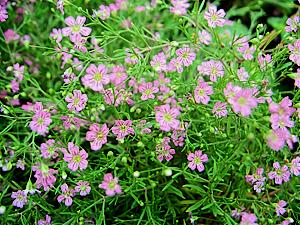 Gypsophila Garden Pride This delicate annual plant has fine foliage and is covered in minute pink flowers, all summer. It has a branching, mounding habit, that makes it perfect for hanging baskets, window boxes and pots. It can also be planted in the flower garden.
Gypsophila Garden Pride This delicate annual plant has fine foliage and is covered in minute pink flowers, all summer. It has a branching, mounding habit, that makes it perfect for hanging baskets, window boxes and pots. It can also be planted in the flower garden.
Garden Pride is long lasting and heat tolerant. Plant it in full sun and in good, well-drained soil to which some agricultural lime has been added, to sweeten the soil. Water it regularly, never allowing the soil to totally dry out and it will grow quickly to +-20cm tall and +-20cm wide.
Everlasting - Helichrysum bracteatum
 Bracteantha 'Bronze' Bracteantha 'Bronze'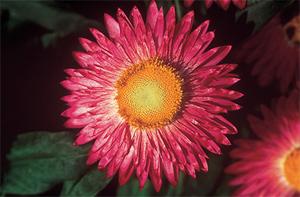 Bracteantha 'Dark Rose' Bracteantha 'Dark Rose'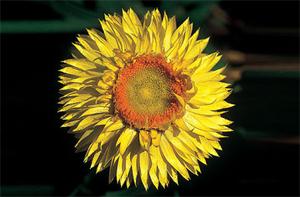 Bracteantha 'Lemon' Bracteantha 'Lemon' |
These perennial plants are native to Australia and are treasured for their showy, single or double, papery flowers in all colours, except blue. The colours include scarlet, red, pink and gold, orange, yellow, purple, maroon or white. The plants will flower all summer until the first heavy frosts. They make excellent cut-flowers and last indefinitely if dried, hence their common name.
There are dwarf, medium and tall varieties. The dwarf varieties grow about 30 to 45cm tall, the medium ones 45 to 60cm, and the tall varieties 60 to 120cm. The dwarf varieties are the most freely available in South Africa and are lovely if grown in containers. They also make excellent bedding plants that will attract butterflies to your garden.
Everlasting flowers grow well throughout South Africa in summer as long as they are planted in full sun and can be watered regularly. They require good, very well-drained soil and the taller varieties need protection from strong winds.
Seeds are sown directly into garden beds and germination is best when in soil temperatures between 20 and 22°C. Do not cover the seeds with soil, as they need light to germinate. The seeds will germinate within 5 to 10 days and will bloom in about 10 to 12 weeks after sowing. Seeds can be collected in autumn to sow again in spring.
Million Bells, Calibrachoa - Calibrachoa syn Petunia
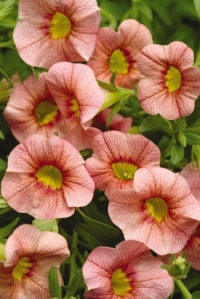 Cabaret Peach Calibrachoa. Picture courtesy Ball Horticultural CompanyCondensed Version:
Cabaret Peach Calibrachoa. Picture courtesy Ball Horticultural CompanyCondensed Version:
Million Bells are short lived perennials which are often grown as summer annuals, growing and flowering at an amazing rate! They bloom all spring and summer, until the first frosts, and in warm frost-free regions can flower all year round. They are available in many sizzling shades of cherry, red, rose, pink, violet, blue, yellow, lemon, terracotta and white. Million Bells partner well with other sun loving annuals in the garden, and their sprawling habit adds a cascading accent for all kinds of containers. Generally they remain below 15cm in height with a spread of +-30 to 60cm wide. In pots they will cascade up to 60cm or more.
Million Bells are easy to grow as long as you meet their growth requirements. They flower best in full sun, although in very hot regions some midday shade may be welcome. Although they will grow in most garden soils which have perfect drainage, Million Bells thrive in slightly acidic soils, so if your soil is alkaline, add acid compost to the planting beds. If you're planting into containers, use a top quality, free-draining potting mixture.They also require good air movement around their leaves, so place them where there is a slight breeze. Water as needed in hot weather, but allow the soil to partially dry out before watering again.
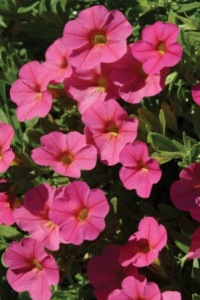 Cabaret Hot Pink Calibrachoa. Picture courtesy Ball Horticultural CompanyFull Version:
Cabaret Hot Pink Calibrachoa. Picture courtesy Ball Horticultural CompanyFull Version:
Description, History & Interesting Facts:
Million Bells are closely related to petunias and are found across much the same region of South America as petunias, from southern Brazil across to Peru and Chile, inhabiting scrub and open grassland. And, although they look like a miniature petunia, and were previously included in petunia, scientists now say they are not quite petunias, because amongst other things, petunias have 14 chromosomes and calibrachoa has 18.
Million bells is a relatively recent newcomer to the garden scene, having only been around since the early 1990s - that’s not long in plant years. Plant breeders have been hard at work on this little marvel, and today Million Bells in available to gardeners in many sizzling shades of cherry, red, rose, pink, violet, blue, yellow, lemon, terracotta and white. They will bloom all spring and summer, until the first frosts, and in warm frost-free regions can bloom all year round. They generally remain below 15cm in height with a spread of +-30 to 60cm wide. In pots they will cascade up to 60cm or more.
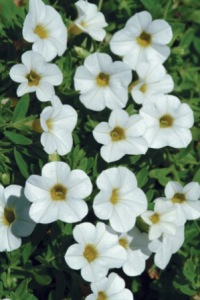 Cabaret White Calibrachoa. Picture courtesy Ball Horticultural CompanyIn the Garden:
Cabaret White Calibrachoa. Picture courtesy Ball Horticultural CompanyIn the Garden:
Million Bells partner well with other sun loving annuals and their sprawling habit adds a cascading accent for all kinds of containers, including window boxes, hanging baskets and combination planters. Let them trail down banks, over low walls or tall pots, or plant them in massed plantings as a groundcover.
Cultivation/Propagation:
Million Bells are short lived perennials which grow and flower at an amazing rate! They are also easy to grow as long as you meet their growth requirements. They flower best in full sun, although in very hot regions some midday shade may be welcome. Although they will grow in most garden soils which have perfect drainage, Million Bells thrive in slightly acidic soils, so if your soil is alkaline, add acid compost to the planting beds. If you're planting into containers, use a top quality, free-draining potting mixture.
They also require good air movement around their leaves, so place them where there is a slight breeze. And, although the plant is water-wise, this does not mean that it does not need watering. Water as needed in hot weather, but allow the soil to partially dry out before watering again. Overwatering is the leading cause of plant failure, causing black root rot.
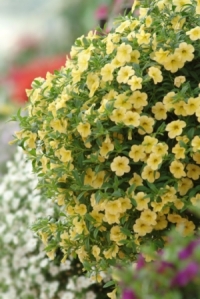 Cabaret Yellow Calibrachoa. Picture courtesy Ball Horticultural CompanyThe plants are self-cleaning, meaning that they shed their spent flowers naturally and replace them with new ones, but an occasional light pruning and a bit of dead-heading won’t harm them.
Cabaret Yellow Calibrachoa. Picture courtesy Ball Horticultural CompanyThe plants are self-cleaning, meaning that they shed their spent flowers naturally and replace them with new ones, but an occasional light pruning and a bit of dead-heading won’t harm them.
Because these plants bloom continuously, those growing in garden beds will benefit from a monthly feeding, using a fertiliser for flowering plants. For potted plants, feed every second week with a liquid fertiliser, which is easiest to apply without burning, and you can also mix slow release fertiliser into the soil when planting.
Calibrachoa can be propagated easily from cuttings but propagation is prohibited by plant breeder rights in many countries. Although the plants produce few seeds, the seed is also easily propagated.
Sow seed in a sterile medium- 1 part sphagnum peat to 1 part sand, works well. Sow the seed on the surface, then press lightly into the soil. Keep the soil moist and at about 23°C. Transplant when the seedlings are about 5cm tall.
Take cuttings about 5cm long from the branch ends. Sink the ends in a sand and peat mixture. Keep moist but not soggy until rooting takes place.
![]() Problems, Pests & Diseases:
Problems, Pests & Diseases:
If grown correctly, Calibrachoa is generally very healthy. However, too much moisture and shade will make it susceptible to root rot, crown rot, and collar rot. To help prevent this, water early in the day and provide plenty of sunshine to keep the foliage and the flowers dry. This is especially important in humid areas.
Calibrachoa is less sensitive to pests than petunias, but may attract a few pesky bugs like thrips, aphids, and whiteflies. These can be treated with organic insecticidal soap sprays.
Warning:
We could not find any information listed for Calibrachoa.
Torenia, Wishbone Flower - Torenia fournieri
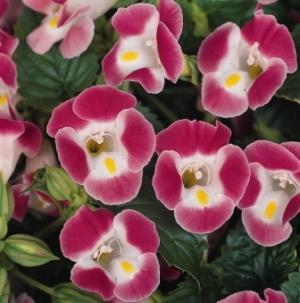 Clown Rose Improved ToreniaThese delightful flowers are native to south eastern Asia; Viet Nam in particular, and will bloom consistently all summer through autumn, until the first frosts. They can take heat, humidity and shade, and there are not many annuals that can accomplish that. The intense colours range from light and dark blue, to burgundy, pink, rose; lavender and white. They make great plants for window boxes, pots and hanging baskets as long as you don't allow them to dry out. They are wonderful edging plants and if planted in groups will make a charming display.
Clown Rose Improved ToreniaThese delightful flowers are native to south eastern Asia; Viet Nam in particular, and will bloom consistently all summer through autumn, until the first frosts. They can take heat, humidity and shade, and there are not many annuals that can accomplish that. The intense colours range from light and dark blue, to burgundy, pink, rose; lavender and white. They make great plants for window boxes, pots and hanging baskets as long as you don't allow them to dry out. They are wonderful edging plants and if planted in groups will make a charming display.
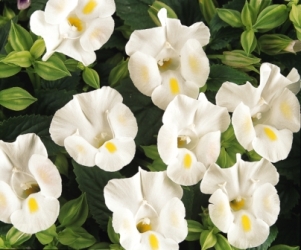 Clown White Blush ToreniaWishbone Flowers grow best in semi-shade and require rich well-drained soil and regular watering; especially during hot, dry periods. They will grow quickly to about 20cm tall and 15cm wide and are tender to frost. Protect them from strong wind and feed your plants every 2 weeks or so, especially if they are growing in containers. If you live in a temperate region you can grow wishbone flowers all year round. When the plants are small pinch shoots off gently to encourage them to bush out.
Clown White Blush ToreniaWishbone Flowers grow best in semi-shade and require rich well-drained soil and regular watering; especially during hot, dry periods. They will grow quickly to about 20cm tall and 15cm wide and are tender to frost. Protect them from strong wind and feed your plants every 2 weeks or so, especially if they are growing in containers. If you live in a temperate region you can grow wishbone flowers all year round. When the plants are small pinch shoots off gently to encourage them to bush out.
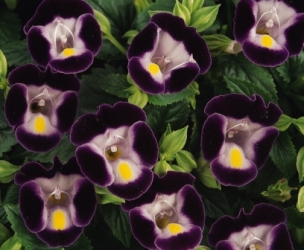 Clown Violet Improved ToreniaSeed can be sown in seedling trays in spring and early summer when the temperatures are between 24 and 26°C. Seed germination is improved by light, so don't cover them; rather just press them gently into the soil surface. The seeds will germinate within 7 to 18 days, and flower in about 12 to 14 weeks after sowing. Grow your seedlings on in a cool place.
Clown Violet Improved ToreniaSeed can be sown in seedling trays in spring and early summer when the temperatures are between 24 and 26°C. Seed germination is improved by light, so don't cover them; rather just press them gently into the soil surface. The seeds will germinate within 7 to 18 days, and flower in about 12 to 14 weeks after sowing. Grow your seedlings on in a cool place.
Monkey Flower - Mimulus x hybridus
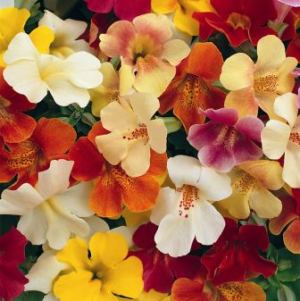 Mimulus Magic Mixed. Picture courtesy Picture courtesy www.ballstraathof.co.zaThese cheerful and rewarding little plants are native to North and South America and Australasia. They are moisture loving plants that thrive in semi-shade and are beautiful planted at water side margins and moist areas
Mimulus Magic Mixed. Picture courtesy Picture courtesy www.ballstraathof.co.zaThese cheerful and rewarding little plants are native to North and South America and Australasia. They are moisture loving plants that thrive in semi-shade and are beautiful planted at water side margins and moist areas
Their gay summer flowers are available in single or mixed shades of bright scarlet, pink, white, yellow, ivory, and orange. There are clear and bi-colours available. They are stunning if planted into hanging baskets, window boxes and pots, or as a border to the flower garden.
Monkey Flowers grow well in the summer rainfall regions and are not suited to very hot, dry or humid regions. They are tender to frost and are generally grown as summer annuals in South Africa. In temperate regions they can be grown all year round. Plant them in semi-shade, and protect them from the hot midday sun. They require good, well- drained soil 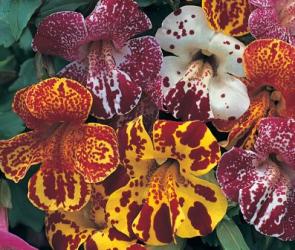 Mimulus Magic Blotch. Picture courtesy The Bedding Plant Growers Associationand thorough watering. If they are planted in good soil it is not necessary to feed them again. When your plants are almost finished flowering shear them lightly to encourage a second flush of blooms. This will keep them tidy and blooming for longer. Monkey Flowers grow about 30cm tall and 25cm wide but there is a smaller variety that only grows about 15cm tall.
Mimulus Magic Blotch. Picture courtesy The Bedding Plant Growers Associationand thorough watering. If they are planted in good soil it is not necessary to feed them again. When your plants are almost finished flowering shear them lightly to encourage a second flush of blooms. This will keep them tidy and blooming for longer. Monkey Flowers grow about 30cm tall and 25cm wide but there is a smaller variety that only grows about 15cm tall.
Seeds can be sown in seedling trays in spring and early summer when the soil temperatures are between 15 and 24°C. Do not cover the seeds as they require light to germinate, rather gently firm them down into the soil. Keep the soil damp but not wet. The seeds will germinate in 14 to 21 days and will flower in about 11 to 13 weeks after sowing. Grow your seedlings on in cool conditions and do not feed them as this makes for lush growth and fewer flowers.
Cineraria, Florist's Cineraria - Pericallis x hybridus
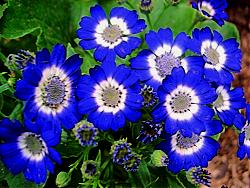 Cineraria 'Blue'Condensed Version:
Cineraria 'Blue'Condensed Version:
Cineraria in full bloom will take your breath away and have everyone wanting to know what it is? They thrive in mild climates where they are grown outdoors in lightly shaded garden beds and pots, putting on a breath-taking show in winter and spring. The garden hybrids we grow today form beautifully neat mounds of deep green, slightly lobed leaves, and when in full bloom the plant is almost completely covered by immense clusters of velvety daisy flowers in many vibrant colours like blue, purple, lilac, white, pink and rose. Cineraria are also popular pot plants and will bloom for up to 6 weeks indoors if cared for correctly.
These tender winter annuals are available from garden centres in seedling trays and pots, and this is probably the easiest way to grow them, although seed can also be sown in late summer. They are tender to frost, but in moderately cold regions can still be grown outdoors in sheltered positions, underneath roofs. They thrive in semi-shade to sun, and it is essential that the soil is rich and fertile, but very well-drained. Cineraria are also fairly thirsty plants, due mainly to the large volume of flowers they produce, and like to be kept moist but not soggy, at all times. These plants are extremely susceptible to fluctuations in watering; overwatering will cause root rot and under watering decreases flowering. While they are in bloom, feed monthly with a liquid plant food for flowering plants.
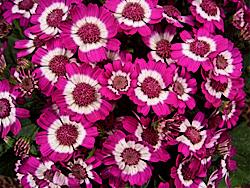 Cineraria 'Pink & White'Full Version:
Cineraria 'Pink & White'Full Version:
Description, History & Interesting Facts:
Cineraria in full bloom will take your breath away and have everyone wanting to know what it is? These exotic looking plants belong to the daisy family and are native to the Canary Islands and Madeira, and what makes the garden hybrids we grow today so special is that they form beautifully neat mounds of deep green, slightly lobed leaves, and when in full bloom the plant is almost completely covered by immense clusters of velvety daisy flowers in many vibrant colours like blue, purple, lilac, white, pink and rose.
The very first hybrid was developed in the British royal gardens in 1777 and was originally known as Cineraria × hybrida, but the genus Cineraria is now restricted to a group of South African species, with the Canary Island species being transferred to the genus Pericallis. Today we are blessed with both single and bicoloured strains, as well as dwarf and tall varieties.
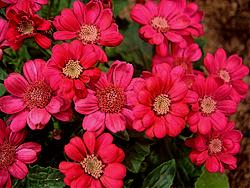 Cineraria 'Pink'In the Garden & Home:
Cineraria 'Pink'In the Garden & Home:
Cineraria are perfect in mild climates where they are grown outdoors in lightly shaded garden beds and pots, putting on a breath-taking show in winter and spring. Fill your pots, hanging baskets and window boxes with dwarf cineraria for both colour and form. The dwarf varieties also make an excellent border plant for the shade-garden and the taller varieties give bold accent to mixed flowerbeds.
In cold, frosty regions they can be used outdoors in shady, sheltered positions under the roofs of patios or entrances, where they are protected from frost and freezing winds.
This heat-sensitive plant is grown in large quantities by the florist industry for indoor enjoyment in the mid to late winter months, and potted plants will bloom for up to 6 weeks indoors if cared for correctly.
![]() Cultivation/Propagation:
Cultivation/Propagation:
Cineraria are available from garden centres in seedling trays and pots, and this is probably the easiest way to grow them, although seed can also be sown in late summer. They are ideally suited to temperate climates where they are grown outdoors. Temperate or tepid latitudes of Earth lie between the tropics and the Polar Regions, and although these regions have more variety in temperature over the course of the year and more distinct changes between seasons compared with tropical climates, the climate remains moderate, without excessive heat or cold.
These winter annuals are tender to frost, but in moderately cold regions can still be grown outdoors in sheltered positions, underneath roofs. They thrive in semi-shade to sun, but ensure they get sufficient sun to flower well. It is essential that the soil is rich and fertile, but very well-drained. Cineraria are also fairly thirsty plants, due mainly to the large volume of flowers they produce, and like to be kept moist but not soggy, at all times. These plants are extremely susceptible to fluctuations in watering; overwatering will cause root rot and under watering decreases flowering.
While they are in bloom, feed monthly with a liquid plant food for flowering plants. Modern varieties are bred to be relatively compact and extremely floriferous. Remove the spent flowers regularly and clip off any yellowing leaves.
Cineraria are popular pot plants and will bloom for up to 6 weeks indoors if cared for correctly. Place them in a cool place indoors with bright light, and away from cold draughts. Water regularly, never allowing the potting mixture to dry out totally. Try not to wet the leaves with water, and increase the humidity around your plants by filling drip trays with tiny pebbles or gravel, which is kept damp. Place your pot on the damp pebbles and the slowly evaporating water will add humidity around the leaves. Do not let the pots stand directly in trays of water or they will rot. The plants are discarded when they have finished blooming.
Seeds can be sown in seedling trays in late summer (March - April) and germinate best in soil temperatures between 21 and 24°C. Cineraria seeds require light for germination, so do not cover them. They can take up to 2 weeks to germinate, and will take about 16 to 20 weeks to flower. Stem cuttings can be rooted in evenly moist soil and mist sprayed occasionally.
![]() Problems, Pests & Diseases:
Problems, Pests & Diseases:
Watch out for insects like thrips, aphids, whiteflies, leaf miners and red spider mites. Also check for powdery mildew on the leaves.
Warning:
Pericallis x hybridus is not listed as a poisonous plant.
Primrose, German Primrose - Primula obconica
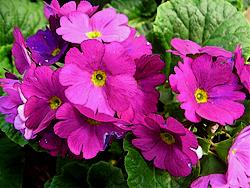 The primrose family is a very large one, consisting of about 500 species that are mostly indigenous to the Northern temperate zones, with about 300 species native to China.
The primrose family is a very large one, consisting of about 500 species that are mostly indigenous to the Northern temperate zones, with about 300 species native to China.
These small growing plants are like miniature floral bouquets with their clusters of cheerful flowers in a rainbow of colours from yellows and oranges to reds, pink and lilac, blue, purple and white. They flower profusely in winter and spring to early summer and many long-blooming, large-flowered varieties are available. Plant them in pots, window boxes and hanging baskets or use them as a border to the shady flower garden. They combine beautifully with spring flowering bulbs.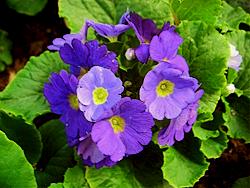
German Primroses are short-lived perennials that are grown as annuals in South Africa. They thrive in moist, rich soil and are semi-hardy to frost if planted in a protected position outdoors, but they will not tolerate heat. Plant them in semi-shade and water them regularly; never allowing the soil to dry out totally but not allowing it to become soggy. The German Primrose will 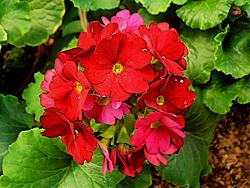 grow about 20cm tall and 20cm wide.
grow about 20cm tall and 20cm wide.
Seeds can be sown in seedling trays in autumn, germinating best in soil temperatures between 15 and 21°C. The seeds will germinate within 14 to 21 days and flower about 24 weeks after sowing. Do not cover the seeds until they grow their first white 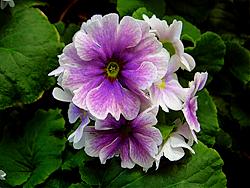 shoots; then lightly sprinkle vermiculite over them. During germination, maintain moderate moisture levels, never allowing the seed to dry out or to become saturated. Following germination, reduce moisture levels somewhat, allowing the growing medium to dry out slightly before watering, to help promote rooting.
shoots; then lightly sprinkle vermiculite over them. During germination, maintain moderate moisture levels, never allowing the seed to dry out or to become saturated. Following germination, reduce moisture levels somewhat, allowing the growing medium to dry out slightly before watering, to help promote rooting.


